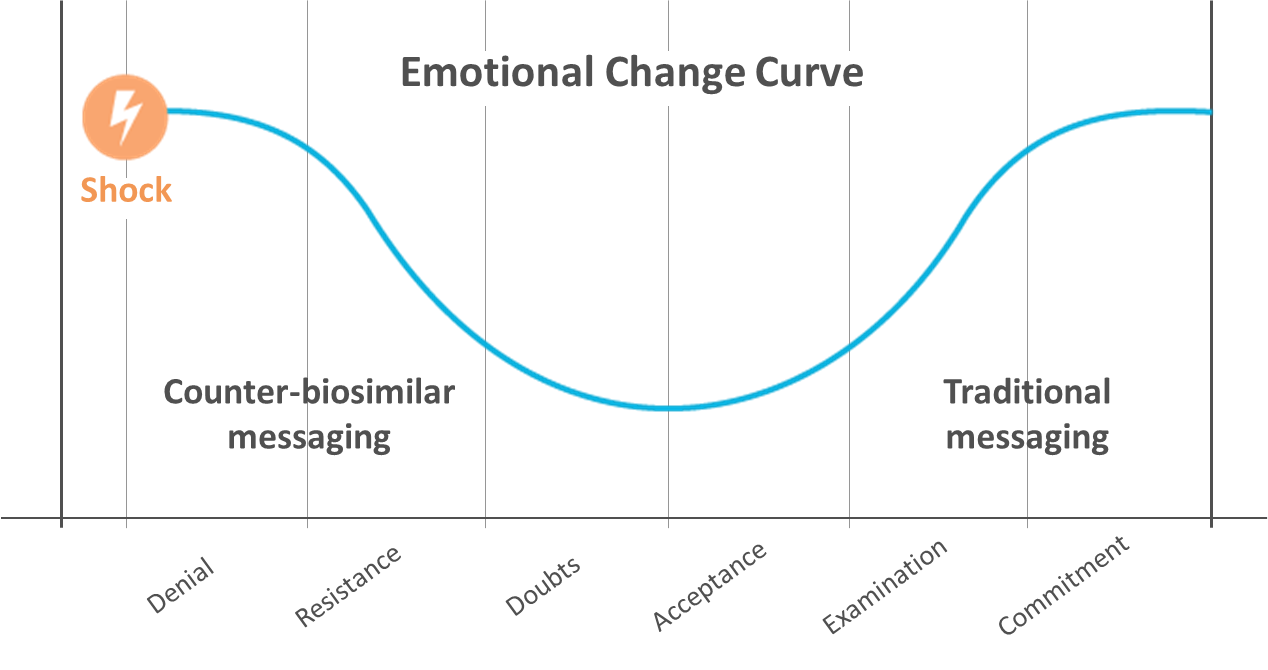Biosimilars are an inevitable and disruptive force in pharma. For biologic originators, messaging strategy is one of the important levers to use to defend biosimilar competition. The challenge for biologics at the end of their patent protection is how to communicate the tangible and/or emotional benefits of the branded product in the face of assumed (and real) price differences with biosimilars.
With messaging, often we look for the message most likely to drive adoption. But counter-biosimilar messaging aims for the opposite of adoption. It aims to evoke the emotion of inertia and to delay the uptake of biosimilars.
What is Counter-biosimilar Messaging?
What is unique about counter-biosimilar messaging? To better answer this question, let’s use the emotional change curve below to illustrate. Let’s first look at traditional messaging. The purpose of traditional messaging is to appeal to the emotions on the right side of the change curve, such as commitment, in order to drive the adoption of a product. “Talk to your doctor about product X” is an example of such messaging. It is a call-to-action messaging. However, the purpose of counter-biosimilar messaging is to justify the emotions on the left side of the change curve, such as resistance. In other words, counter-biosimilar messaging is a call-to-inaction messaging.
Why Appeal to the Other Side of Emotions?
Our vast experience in CPG and telecom messaging research makes this reinforcement of a negative emotion seems like a very counter-intuitive strategy. We usually recommend to stay on the positive side of emotions. However, traditional messaging falls short in addressing the unique competitive dynamics of biologic-biosimilar:
- The goal is different. Counter-biosimilar messaging aims to delay the inevitable adoption of biosimilars as opposed to maintaining market share for biologics.
- There is a dominant choice. Switching to a lower-cost biosimilar seems to be the dominant choice from a health economics perspective. It is a much tougher uphill battle for the branded originators.
- Risk-aversion is the key emotion. Deliberation over the risks of switching biologics naturally resonates with emotions such as resistance.
From a behavioral science perspective, messaging against a dominant choice is more difficult and less effective than messaging to the cognitive biases (e.g., loss-aversion) being used. The key is to appeal to emotions such as resistance or hesitation without coming off negatively, which is a very fine line. Simply throwing darts towards biosimilar competitors may back-fire.
Case Study: Identifying and Optimizing a Counter-biosimilar Message Platform
As part of a biosimilar defense strategy, a multi-billion dollar biologic brand was investigating in the most effective message platform to defend against biosimilar competition. A message platform is a foundation that all communications for future marketing activities spring from. To identify and optimize such a message platform, two phases of research were involved.
The first phase is to qualitatively explore various message themes and emotions to inform message creation and iteration. With a hybrid approach (qualitative interviews with quantitative elements), an initial set of message platforms were selected.
Second, a quantitative trade-off exercise was used to identify and optimize the most effective message platform. In addition to understanding the hierarchy of messaging, a message combo was identified to maximize the reach of stakeholders.
How does one measure the impact of counter-biosimilar messaging in research? It is necessary to establish a new set of metrics, a set based on the emotion of inertia or inaction. To do so, we need to flip our thinking on the metric end points. In traditional messaging research, the metrics to measure messages are heavily focused on adoption. For example, we look at the likelihood of prescribing. But in the counter-biosimilar case, we need to measure hesitation or anticipated wait before trying biosimilars. With this new set of metrics, how well does counter-biosimilar messaging work? In this case, the winning message doubles the size of non-prescribers and increases the anticipated wait time by 25% before trying biosimilars.
Perspective Matters: The Conversation Changes
For a long-established biologic brand, is there anything new to say about the brand? Yes, the key to counter-biosimilar messaging strategy is to change the conversation by changing the perspective. A realization of an inertia-driven behavioral goal of messaging is critical to this conversation.
Launch and end-of-patent messaging strategies are different. Unlike traditional messaging, counter-biosimilar messaging is about creating inertia. As we change the perspective, themes that are not suitable to support adoption at product launch may be essential and differentiating to create inertia at the end of lifecycle (e.g., consistent manufacturing process, complex molecule structure).
Secondly, the decision influencing power of stakeholders may shift. We may have to re-think relationship dynamics and types of messages that work for key stakeholders (e.g., physicians, nurses, patients, payers). Patients may have a much stronger influencing power at the end of lifecycle. Tactically, a long-established brand can rely on a stronger capability to target and segment their patients via patient support programs.
Finally, counter-biosimilar messaging is part of overall defense strategy. The implication of delay of biosimilar adoption is not only about the financial impact in short-term, but also more time to transition patients to the brand’s patent-protected new formulation or next-generation product.





